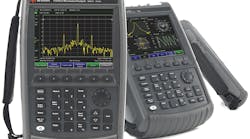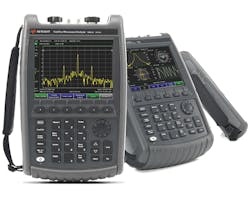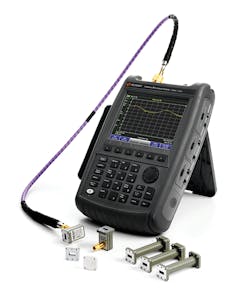This file type includes high resolution graphics and schematics when applicable.
FieldFox handheld analyzers from Keysight Technologies have already demonstrated their effectiveness for field and laboratory measurements at RF/microwave frequencies. To inject further flexibility into the FieldFox family, the company recently developed six new FieldFox analyzers for millimeter-wave frequency coverage to 50 GHz.
Ideal for maintenance and troubleshooting of systems such as satellite communications (satcom) earth stations, line-of-sight communications links, and radar systems, the analyzers offer different performance levels for use to 32, 44, and 50 GHz (Fig. 1). Each unit can replace three or more separate test instruments, including spectrum analyzers, vector network analyzers (VNAs), power meters, and more.
Spectrum and Combo Analyzers
This latest series of millimeter-wave analyzers consists of three models that are solely spectrum analyzers and three models that combine the functions of multiple instruments, including spectrum analyzers, cable and antenna analyzers, and VNAs. Within a compact package, each features a straightforward layout, with clear display screen, large keypad for data entry and control, and top-mounted connectors for ease of linking signal inputs and outputs. All six new higher-frequency models, as well as earlier models, offer a built-in power meter and can perform pulse, channel power, interference measurements, etc.
The three new combination analyzers cover 32, 44, or 50 GHz and provide spectrum analysis, vector network analysis, and cable and antenna testing among their measurement capabilities. The three spectrum-analyzer models cover the same frequency ranges (see the table). All FieldFox analyzers are well-suited for field use; the combination analyzers with their additional measurement functions also prosper as laboratory instruments.
The analyzers are designed for tough conditions—they comply with US MIL-PRF-28800F Class 2 standards and are type-tested to meet MIL-STD-810G requirements for operation in explosive environments (Method 511.5, Procedure 1). Circuitry is contained in sealed enclosures with no fans or vents, and even test connectors are mounted in a connector bay at the top of each instrument for protection from mishandling. The rugged enclosures are also type-tested to meet IEC/EN 60529 IP53 requirements for protection from dust and water.
Each enclosure includes a side strap for ease of transport, and test results are shown on an antiglare 6.5-in.-diagonal liquid-crystal-display (LCD) screen with light-emitting-diode (LED) back light. The FieldFox analyzers measure just 11.5 × 7.4 in. (292 × 188 mm) and they weigh only 7.1 lbs. (3.2 kg) with their rechargeable lithium-ion battery.
The circuitry shared by all six new FieldFox models is impressive and certainly matches any larger, benchtop spectrum analyzers on the market. They feature resolution bandwidth filters from 10 Hz to 5 MHz wide, with video bandwidth filters from 1 Hz to 5 MHz. The analyzers deliver high stability and low noise for in-field measurements, as evidenced by phase noise offset 10 kHz from a 1-GHz carrier at typically –111 dBc/Hz, and phase noise offset 1 MHz from the same carrier typically dropping to –113 dBc/Hz.
Without any warm-up, the FieldFox analyzers deliver typical amplitude accuracy of ±0.35 dB from 100 kHz to 18 GHz and typically ±0.5 dB from 18.0 to 26.5 GHz. Typical amplitude accuracy through 50 GHz is ±0.5 dB. The displayed average noise level (DANL) is also remarkable, at typically only –157 dBm from 2.1 to 2.8 GHz, –152 dBm from 7 to 13 GHz, –149 dBm from 13 to 22 GHz, and –135 dBm or better from 40 to 50 GHz.
Out in the Field
Of course, having multiple measurement functions in a handheld unit encourages its use in the field (Fig. 2). The cable and antenna analyzer can perform testing on in situ cables in systems, including one-port cable-loss measurements and two-port insertion-loss measurements. It can also perform time domain reflectometry (TDR) in search of faults in cables and coaxial connections, as well as perform distance-to-fault (DTF) measurements to find the precise location of a cable fault. In fact, these higher-frequency analyzers are available with a long list of accessories, including waveguide adapters for use at higher frequencies (Fig. 3).
But the cable and antenna analyzer is just one side to this multiple-function instrument. As microwave VNAs, these analyzers are able to provide calibrated measurements on popular scattering parameters, such as S{SUBSCRIPT 21}. However, they can also be used for full two-port measurements on all four S-parameters, including magnitude and phase as well as time-domain analysis. A number of useful applications notes are already available for these new analyzers, and cover FieldFox measurements to 50 GHz.
With the “CalReady” feature, which is the built-in calibration capability, the portable analyzers are ready to perform S-parameter measurements, DTF testing, and time-domain reflectometry (TDR) without connecting additional equipment to do a calibration. In addition, they can be quickly calibrated over broad frequency ranges, enabling them to perform accurate, calibrated measurements over broad bandwidths. The analyzers also support traditional mechanical and e-Cal calibration kits as used with benchtop RF/microwave analyzers.
When equipped with the spectrum-analyzer gating option (Option 238), FieldFox instruments provide gated fast Fourier transform (FFT) capability. This enables the capture and analysis of high-speed pulsed signals. Pulse-viewing capability is a function of the gate time. For example, with a short gate time set from 6 µs to 1.8 s, multiple pulses with short rise and fall times can be captured and viewed for analysis. FieldFox functions such as automatic trigger delay and bandwidth settings help simplify testing on pulsed signals.
FieldFox analyzers contain an integral test signal source, operating to 50 GHz depending on the model. The signal source can be tuned to any frequency, independent of the spectrum-analyzer frequency, or act as a traditional tracking generator.
Another useful function for checking and characterizing high-frequency cables is the extended range transmission analysis (ERTA) option offered with the spectrum-analyzer functionality. Such measurements require analyzers with high dynamic range and fast measurement speed, especially when checking over long lengths of cable where much test data will be developed. Microwave scalar network analyzers (SNAs) traditionally perform such measurements, although they have always been benchtop in nature and limited in their usefulness for in-field measurements.
FieldFox analyzers with the ERTA capability provide the means to measure dynamic ranges as large as 108 dB at 6 GHz and 77 dB at 26.5 GHz without calibration or warm-up period. The ERTA process requires two FieldFox analyzers, one placed at each end of a cable to be analyzed. One of the analyzers serves as a test signal source while the other acts as a test receiver. By using Keysight’s proprietary InstAlign technique, cable-loss measurements can be made across long runs of coaxial cable with ±0.7-dB accuracy.
Other Built-In Features
Each of the new millimeter-wave FieldFox analyzers incorporates a built-in variable dc supply for powering probes, external bias tees, and amplifiers under test. The analyzers achieve calibrated measurement accuracy without the tedious mechanical calibration via a Keysight function known as QuickCal (which is usable to 18 GHz).
A built-in Global Positioning System (GPS) satellite receiver provides geographic-location tags for measurements. The time, latitude, longitude, and elevation can be displayed with a measurement for ease of record keeping. In addition, each analyzer includes multiple Universal Serial Bus (USB) ports and a LAN port for ease of data transfer and standard programming commands for programmable instruments (SCPI).
An iOS device, such as an iPhone, iPad, or iPod Touch device can be used to remotely operate the FieldFox analyzers. The Remote View iOS application software provided with each instrument emulates the analyzer’s front panel on the iOS device, allowing a user to activate any control key remotely from the iOS device. In addition, the complimentary FieldFox Data Link software simplifies data transfer, data definition, and report generation. The software makes it possible to add markers and limit lines to traces and load different files and factors to help create meaningful records of high-frequency measurements.
Power in the Palm
From their appearance, the FieldFox analyzers don’t present the image of “benchtop austerity” offered by larger, rack-mount laboratory instruments. Nonetheless, they can match those larger instruments in terms of measurement performance and accuracy. Plus, they’re truly portable, fitting in the palm of a hand. The analyzers weigh only 7.1 lb. (3.2 kg) even with their rechargeable lithium-ion battery and will typically run for 3.5 hours on a battery charge.
FieldFox analyzers come loaded with the measurements needed to characterize cables and other components in the field, including DTF, insertion loss, return loss, and VSWR in a single test sweep. In addition, they provide the means to monitor signals in the environment to 50 GHz, which should put these instruments on the “wish lists” of quite a few government agencies and agents.
To learn more about these new FieldFox analyzers, visit www.keysight.com/find/first50MWRF. P&A: $28,000 and up (32-GHz and higher models); stock.
Keysight Technologies Inc., 1400 Fountaingrove Pkwy., Santa Rosa, CA 95403; (707) 577-2663.





